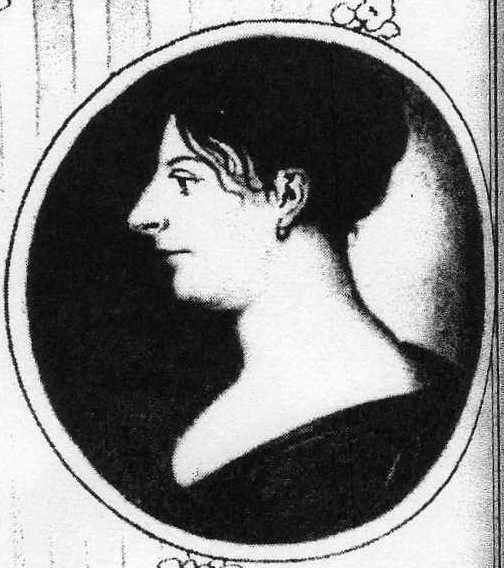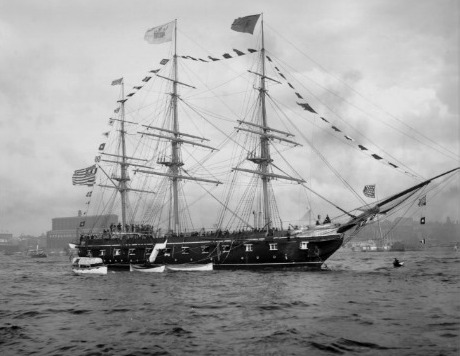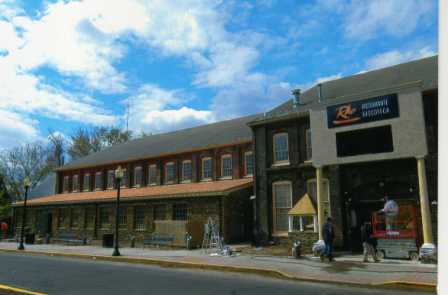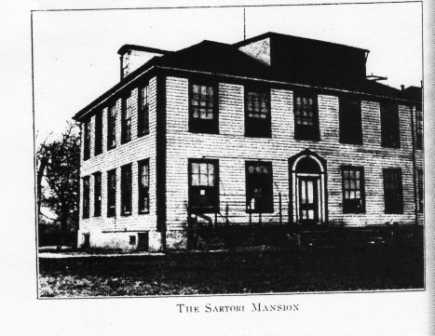
SARTORI FAMILY 1830-1850
BY TOM FRASCELLA JANUARY 2014
It is appropriate at this point in our history to include more information about the Sartori family during the period 1830-1850. This very notable Trenton family, as previously written, is distinguished for partially financing and building the first Catholic Church in New Jersey, St. John the Baptist 1814. The family is also distinguished as the first prominent Italian family to settle in Trenton area in the year 1800. Since my initial writings concerning the family I have had an opportunity to do more research which has lead to this article.
By way of background the Vatican or Papal States were among the first of the European governments to recognize the “infant” United States as a sovereign nation. In fact he Papal Nuncio of Paris wrote to the American Peace Commissioners at the Treaty of Paris that Papal ports in Italy were open to the New Republic in 1784. By so doing the Papal Nuncio had invited economic commerce with the new nation before the Constitution or even Article of Confederation had been drafted or ratified. Despite this early invitation and sovereign recognition no formal response from the U.S. was made. Trade between the two entities did however slowly develop. A second attempt at establishing a consulate relationship was again initiated by the Vatican in 1797. At the urging of the Vatican a young Italian merchant by the name of Giovanni Battiste Sartori wrote to Robert Morris, Signer of the Declaration of Independence, U. S. Superintendent of Finance and Pennsylvania Senator. Morris had been since the Revolution one of the most influential economic leaders in the U.S. and a logical choice to direct U.S. “economic” inquiry. At the time President Washington resided in the U.S. Capitol of Philadelphia. The Presidential mansion being the Philadelphia home of Robert Morris who graciously rented it to the U.S. for the Sartori offered his services to the U.S. as U.S. consul to Rome. Those services were accepted and he was appointed by the U.S. that same year to the non-paying post. He therefore became the first U.S. consul to Rome and served in that capacity until 1800 although some documents list him in that capacity until 1806. However the Vatican sent him to the U.S. to serve as their consul here in 1800. As an aside the U.S. did not appoint an American to serve as consul to Rome until 1837 relying instead on Italian citizens for that purpose. In 1837 George W. Greene, grandson of Revolutionary War hero Gen. Nathaniel Greene was appointed as the first U.S. born consul to the Papal States.

Giovanni Battiste Sartori
Giovanni Battiste Sartori arrived in America in 1800 as economic emissary of the Vatican State to the United States. He settled in Trenton, where he met and married French ex-pat. Henriette de Woofoin in 1804. Together they had fourteen children born to the marriage while they lived in Trenton, however three died either in child birth or infancy. This includes twins who died in childbirth along with their mother in 1828.

Henriette de Woofoin Sartori
In 1832 Giovanni Sartori returned to Leghorn, Italy where he would live out the remainder of his life, dying in 1858 at the age of ninety- eight. Of the eleven surviving children of Mr. Sartori’s family it would appear that five either returned to Italy with him or subsequently joined him there. The children who returned to Europe were daughters Magdalena, Isabella, and Clementina and sons Vincent and Augustus. Vincent died in 1835.
Six Sartori children remained in the United States. Those children remaining in the U.S. were daughters Eugenia, Mathilda, and sons Charles, Lewis, Victor and Edmund. It would appear that business, marriage and professional pursuits slowly drew the family away from their Trenton origins.
Two of the sons, Victor and Edmund became merchants. Victor opened successful business ventures in Philadelphia were he spent the rest of his life. Edmund followed his merchant vocation as far a China, before eventually settling down and marrying in South America. Interestingly, one of Edmund’s sons, Luigi, became a priest and eventually returned to the United States where he spent the last twenty-five years of his life assigned to the Diocese of Baltimore. Among the Rev. Luigi Sartori’s accomplishments was the establishment and building of St. Stephen’s Church in Upper Falls, Maryland.
Of the two American daughters Mathilda married P. Jauretche and took up residence in Philadelphia. Eugenia the oldest of the Sartori daughters married Peter A. Hargous, son of John Hargous who was a business partner and co-sponsored the building of St John’s Church with Giovanni in1814. It is Eugenia and her husband Peter that maintained the longest connection to Trenton, but their principle place of residence during their marriage was New York City. I will address the accomplishments and contributions of this couple to the Country, State and local community in the February’s article.
The remaining two Sartori children who also stayed in the U.S. were Charles the oldest and Louis. Charles graduated from Jefferson medical college and began a career in medicine. He too moved away from Trenton establishing his medical practice in what today would be Atlantic and Burlington counties in N.J. Later although in his fifties Charles enlisted and served as ship’s surgeon on several Union warships during the U.S. Civil War, including one the U.S.S. Portsmouth commanded by his brother. Charles resigned his commission and retired from active duty in 1864. After Charles retired he relocated to Camden N.J. After relocating to Camden, Charles began a second career in Camden as a school principal and later as President of the Camden Board of Education. He was also an officer in Camden’s Masonic Lodge. Of all of the Sartori children Charles was the only one to reside in New Jersey his entire life.
As I briefly referenced above Louis C. Sartori was a U.S. naval officer. Prior to Giovanni Sartori’s return to Italy he managed to secure for his son Louis a highly prized commission as a midshipman in the U.S. Navy in 1829. At the time Louis was 17 years old. Louis was among the last generation of U.S. Naval Officers trained and educated in what is called the “old” navy. This means he learned his sailing skills and was trained for command as resident aboard ship. The U.S. Naval Academy, a land academy, was not established until the early 1840’s and the date of the establishment of the Academy marks the beginning of the “new” Navy.
Louis advanced in his naval career attaining the rank of lieutenant in 1841. During the U.S.-Mexican War (1847-1848) Louis was assigned to the U.S.S. Stromboli which saw action off the coast of southern Mexico. Naming a warship the Stromboli might seem odd today, but in fact three U.S. warships have been named after the Italian island. During the conflict Louis served with great distinction and lead naval and marine landing forces in the capture of Goatzacoalces and Tabasco.
These landings seem obscure today but at the time of the war the U.S. intent was to obtain territorial and treaty concessions from Mexico. Most of us realize that this is the war in which most of the U.S. southwest, including California, became a U.S. territory.
The above landings were part of a U.S. military action designed to secure treaty rights of passage across southern Mexico starting at Veracruz and proceeding across a narrow strip of land to the Pacific 120 miles away. The action included joint naval and army actions lead in part by the U.S. consul to Veracruz , commissioned a Coronel by the name of Louis Hargous, brother-in law to Louis’ sister Eugenia. The Hargous’ were involved in attempting to build a canal/ railroad across the Tehuantepec isthmus of Mexico connecting the Atlantic and Pacific. Again, this is a topic for the February article on the Hargous family.
In one of the ironies of history while Louis was engaged in his operations on Mexico’s southeastern shore, the U.S.S. Portsmouth was engaged in a landing in Mexico’s northwest coast at the port of Yerba Buena. The landing and capturing of Yerba Buena gave the U.S. territorial claim to the entire Mexican province/state of California. After its capture and annexation to the U.S. the town of Yerba Buena under went a name change in 1847. It then and now became known as San Francisco. The U.S.S. Portsmouth became the ship that Louis would command in the blockade of the Mississippi at New Orleans during the Civil War some sixteen years later.

Photograph of the U.S.S. Portsmouth
In Trenton, the Sartori mansion known as “Rosy Hill” remained in the family until 1847 when it was sold to the Cooper Hewitt Iron Works and became the home of managing partner Abram S. Hewitt. The Iron Works was founded by Peter Cooper and managed by his son and son-in-law. In 1847 Peter Cooper chose Trenton as the site for locating the Iron Foundry along the Delaware. The relocation of the Cooper Hewitt Iron Works to Trenton is considered the beginning of Trenton’s Industrial development. The original site of the Iron Works is where the Rhea restaurant is today which is housed in the newer, “old Iron Works factory.

Photograph of the Cooper Hewitt factory

Picture of the Sartori “Rosy Hill” Mansion
“Rosy Hill” which overlooked the river was in site of the new Iron Works and so ideally located for its manager Mr. Hewitt. Some people may recognize that Mr. Hewitt would, after several years, eventually return to his native New York City where he would become one of its Mayors.
After the Hewitt family vacated the premises the building was converted into office space for the Iron Works which eventually became known as The American Bridge Company. As office space the building witnessed several historic engineering events. In the 1850’s engineers and architects engaged in the building of the U.S. Capitol travelled to the Sartori/ Cooper-Hewitt building to work on the designs for the cast iron I-beams that were being proposed as support for the Capitol dome. The Cooper Hewitt Iron Works in Trenton being the birth place of cast Iron I-beam design.
Also in 1848 Peter Cooper convinced his friend and fellow engineer John A. Roebling to relocate his wire-rope manufacturing to Trenton. Roebling did, locating his first factory next to the Iron works foundry which produced the Iron strands necessary for Roeblings’ wire rope manufacture. In the late 1860’s John A. Roebling used the office facilities of the Sartori/ Cooper Hewitt building to engineer, plan and draft the designs for the Brooklyn Bridge. One of the interesting facts about the early industrialists like Cooper and Roebling is how much they worked together toward mutual success. It should be understood that this was still a very early period in the development of Trenton and Trenton manufacture. Today we think of Trenton and the old Roebling plants as the employers of thousands of workers. In 1850 the entire population of Trenton was 6,000 people. At the start of the Civil War the Roebling factory located on the Delaware employed 70 people.
© San Felese Society of New Jersey